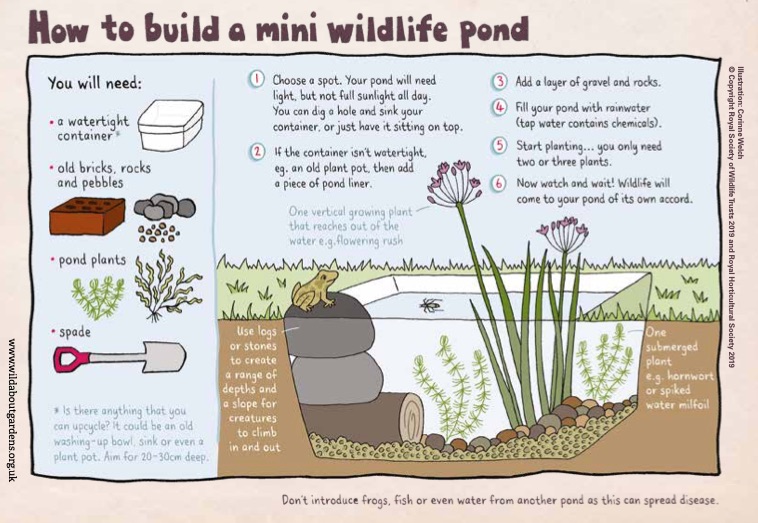
Ponds are wonderful for wildlife and every garden should have one. You don't need a lot of space - even an old bowl sunk in the ground will provide a home for aquatic insects and amphibians, as well as being visited by birds, which can be watched drinking and bathing.
Even if you already have a pond in the garden, children will get great fun out of building one of their very own, and you can be sure that pond life will appear quickly if there is another pond nearby.
The diagram on the left, from the Wildlife Trusts and the RHS, shows how to do it. Pick a spot which is not too shady, and not underneath a tree which will drop leaves into it in the autumn. Dig a hole in which to sink your container. Put some gravel and stones in the bottom. It is important to have one object which protrudes above the water surface so that any air-breathing creatures which visit the pond (e.g. frogs or newts) or might fall in (e.g. mice) can climb out again.
It is best to fill the pond with rainwater. Can your young naturalist devise a way of channeling rain into their pond so as to fill it as quickly as possible? It is generally advised not to transfer in creatures, fish or mud from another pond in case disease is introduced. In any case, it is interesting to see what will arrive without any help from humans, and how long it will take. You could, however, buy a plant or two from a local nursery with an aquatics section. An underwater oxygenating plant will be good for the health of the pond and have the bonus that children can actually see the little bubbles of oxygen produced on a sunny day. It is best not to have fish in a wildlife pond, since they will eat insects, tadpoles etc, so the diversity of creatures in the pond will be reduced.
Recording the building of the pond and subsequent developments as life arrives there in a Nature Journal will add to the fun. You could take some photographs which can be stuck into the journal. When it comes to identifying creatures and plants associated with ponds, links to a variety of identification guides, as well as to further detailed advice on building one, can be found here. These guides may also be useful if you visit a pond or river on trips out with your grandchildren. A magnifying glass will be useful for studying the creatures which live in and around your pond.